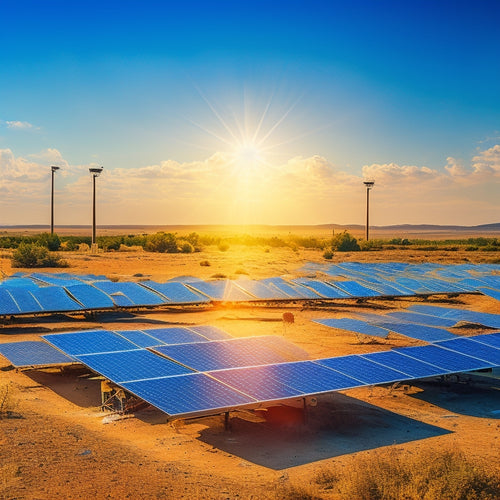
Renewable Energy Controllers in Sustainable Energy Systems
Share
Renewable energy controllers play a vital role in optimizing sustainable energy systems by managing and enhancing performance across various energy sources. By leveraging advanced technologies, you can monitor real-time energy flow, improve reliability, and forecast demand accurately. These controllers guarantee efficient resource allocation, minimize grid overloads, and support smart grid integration, promoting stability. Selecting the right controllers, from solar MPPT to wind energy systems, based on specific energy source needs, also maximizes output and reduces emissions. As you investigate further, you'll uncover more innovative strategies for enhancing energy efficiency and sustainability in your systems.
At a Glance
- Renewable energy controllers optimize electricity flow, enhancing the efficiency of solar panels and wind turbines for better resource management in sustainable systems.
- Smart grid integration allows for effective energy flow management, improving stability and resilience in decentralized energy systems.
- Energy Management Systems (EMS) play a crucial role in predicting energy production and consumption, ensuring responsive and efficient energy distribution.
- Demand response management utilizes predictive analytics to engage consumers and adapt energy consumption during peak demand periods, enhancing system resilience.
- Incorporating advanced technologies in renewable energy controllers helps reduce carbon footprints by improving energy efficiency and minimizing greenhouse gas emissions.
Cost-Effective Energy Management
When you're looking at cost-effective energy management, consider budget-friendly solutions that align with your goals.
By optimizing resource allocation, including the integration of home battery storage systems to store excess renewable energy, you can maximize efficiency while minimizing expenses.
This strategic approach not only enhances performance but also guarantees sustainable energy practices.
Budget-Friendly Solutions
Steering through the terrain of renewable energy management can be overwhelming, but cost-effective solutions make it easier for individuals and businesses alike. By leveraging affordable technology, you can traverse budget constraints while maximizing energy efficiency.
The key to success lies in innovative financing options that allow you to invest in renewable energy without breaking the bank. Engaging in community initiatives not only enhances your project's visibility but also cultivates local partnerships that can lead to cost-sharing arrangements.
These collaborations help distribute financial burdens, making renewable projects more accessible. Additionally, exploring grant opportunities can provide essential funding to support your energy management goals, ensuring you have the resources needed to implement sustainable solutions.
As you consider your options, focus on how these budget-friendly strategies can enable you to achieve energy independence. Embracing these methods not only promotes sustainability but also positions you as a leader in your community.
With the right approach, you can turn renewable energy from an intimidating challenge into an attainable reality, ultimately clearing the path for a greener, more liberated future.
Optimizing Resource Allocation
Maximizing the impact of your renewable energy initiatives requires a strategic approach to resource allocation. To achieve effective resource optimization, you'll want to implement allocation strategies that enhance system performance while aligning with your sustainability assessment goals.
By leveraging technology advancements, you can monitor efficiency metrics that reveal how well your resources are employed in real-time.
Energy forecasting plays a vital role in refining your approach. By accurately predicting energy demand and resource availability, you can make informed decisions that improve renewable integration into your overall energy system. This guarantees that you're not only meeting current needs but also preparing for future challenges.
Consider applying advanced analytics to evaluate your existing resource allocation. This will help you identify inefficiencies and areas ripe for improvement.
As you adapt your strategies based on performance data, you'll cultivate a more resilient energy system that supports your freedom to innovate. Ultimately, the key is to remain flexible and responsive to changes in technology and market trends, allowing you to optimize your resource allocation continuously while pushing the boundaries of what's possible in sustainable energy management.
Enhanced Grid Stability
To achieve enhanced grid stability, you need to utilize smart grid integration alongside effective demand response management.
By optimizing energy flow and adjusting consumption patterns in real-time, you can greatly reduce the risks of outages and fluctuations. This proactive approach not only fortifies the grid but also maximizes the potential of renewable energy sources.
Additionally, the implementation of community solar programs can further contribute to grid stability by distributing energy production across various locations. Such initiatives not only support local energy needs but also encourage a collaborative approach to renewable energy adoption.
Smart Grid Integration
In the domain of renewable energy, integrating smart grid technologies is essential for enhancing grid stability. With the rise of decentralized energy sources, like solar and wind, you need a strong structure to manage fluctuating power outputs.
Smart meter technology plays an important role here, allowing real-time monitoring of energy consumption and production. This data feeds into a broader grid communication system, enabling instantaneous feedback between energy producers and consumers.
By utilizing this connectivity, you can optimize energy distribution, reduce peak load stress, and maintain balance across the grid. The ability to track energy flows in real-time enables you to make informed decisions, enhancing overall system resilience.
Furthermore, advanced algorithms can analyze data trends, predicting demand and adjusting supply proactively.
When smart grids are seamlessly integrated with renewable energy sources, they not only encourage efficiency but also enhance stability. You're equipped to respond to disturbances swiftly, ensuring a reliable energy supply.
Ultimately, this collaboration cultivates a more sustainable and independent energy ecosystem, giving you the freedom to utilize renewables effectively while maintaining grid integrity.
Demand Response Management
As the demand for electricity fluctuates throughout the day, effective demand response management becomes vital for maintaining grid stability. By leveraging predictive analytics, you can forecast demand patterns and prepare for peak load scenarios. This allows for a more flexible demand approach, where energy consumption can be shifted based on real-time monitoring data.
User engagement plays a significant role in this evolving environment. Incentive programs can motivate consumers to adjust their usage during high-demand periods, thereby alleviating stress on the grid.
With energy storage systems in place, surplus energy generated during low-demand times can be stored and deployed during peak load periods, further enhancing grid interactivity.
Automated responses streamline this process, allowing for instantaneous adjustments based on real-time data. When combined with demand forecasting, you can achieve a more resilient energy system.
This innovative approach not only stabilizes the grid but enables you, the consumer, to actively participate in energy management. Ultimately, embracing demand response management paves the way for a sustainable future, where you can make informed choices that contribute to both personal freedom and grid stability.
Key Functionalities Overview
In your exploration of renewable energy controllers, understanding key functionalities like Energy Management Systems and control algorithms is essential.
These components not only optimize energy usage but also enhance overall system efficiency.
For instance, by implementing battery maintenance best practices, you can greatly improve the responsiveness and reliability of your energy solutions.
Energy Management Systems
Energy management systems (EMS) play an indispensable role in optimizing the performance of renewable energy sources. By employing advanced algorithms, these systems allow you to effectively manage energy production and consumption, ensuring a seamless integration of renewable resources into your energy grid. Key functionalities include energy forecasting and load balancing, which are vital for maintaining stability in fluctuating supply and demand scenarios.
Here's a quick overview of the primary functions of an EMS:
| Functionality | Description | Benefits |
|---|---|---|
| Energy Forecasting | Predicts energy production and consumption | Enhances planning and reliability |
| Load Balancing | Adjusts energy distribution across the grid | Prevents overload and outages |
| Real-time Monitoring | Tracks energy use and generation | Increases responsiveness |
| Demand Response | Adjusts usage based on real-time data | Optimizes costs and resource use |
| Integration | Connects renewable sources with existing systems | Streamlines operations |
With these capabilities, EMS equips you to utilize the full potential of renewable energy, supporting a sustainable and resilient energy future. Embracing these technologies, you can achieve greater energy independence and freedom.
Control Algorithms Efficiency
Effective control algorithms are fundamental for maximizing the efficiency of renewable energy systems. By leveraging adaptive control and predictive modeling, you can achieve higher control efficiency and optimize algorithm performance.
Real-time optimization techniques guarantee that your systems respond flexibly to changing environmental conditions, enhancing system responsiveness.
Implementing feedback mechanisms allows for continuous monitoring and adjustment, which is essential for maintaining control strength. Adaptive algorithms can flexibly adjust to fluctuations in energy production and consumption, guaranteeing seamless system integration.
This capability is critical for energy forecasting, as accurate predictions can greatly influence operational strategies.
To evaluate your control strategies, establish performance metrics and efficiency benchmarks that reflect system objectives. This quantitative assessment helps you identify areas for improvement and enhances overall system performance.
By focusing on these key functionalities, you can create a resilient and efficient renewable energy system that aligns with your desire for freedom in energy management.
Incorporating these advanced methodologies into your control algorithms not only enhances efficiency but also enables you to maneuver through the intricacies of sustainable energy systems with confidence and agility.
Selecting Based on Energy Source
When selecting a renewable energy controller, you must consider the specific energy source you're utilizing—solar or wind.
Each type has unique requirements and functionalities that optimize performance and efficiency. For instance, solar systems require key components for reliable performance such as charge controllers that regulate battery charging, whereas wind systems may necessitate different configurations to utilize energy effectively.
Understanding these differences is essential for maximizing energy output and ensuring system reliability.
Solar Energy Controllers
Choosing the right solar energy controller is essential for optimizing your renewable energy system. These controllers manage the flow of electricity between your solar panels and the battery storage or grid, ensuring maximum efficiency.
When you're designing a photovoltaic system, consider two primary types of controllers: PWM (Pulse Width Modulation) and MPPT (Maximum Power Point Tracking).
PWM controllers are simpler and less expensive, but they may limit solar panel optimization. If you're working with larger systems or need to extract every bit of power from your panels, MPPT controllers are the way to go. They adjust the electrical operating point of the modules, greatly improving energy harvest, especially under varying light conditions.
Incorporating smart solar energy controllers into your system not only enhances performance but also contributes to the longevity of your components. Look for features like remote monitoring and data analytics, which enable you to make informed decisions about your energy usage.
Ultimately, the right controller can free you from reliance on traditional energy sources, aligning with a sustainable lifestyle and enhancing your energy independence.
Wind Energy Controllers
As you investigate renewable energy options, wind energy controllers play an essential part in utilizing the power of the wind effectively. By leveraging advanced wind forecasting techniques, you can improve turbine optimization and maximize energy output.
These controllers not only monitor performance but also integrate seamlessly with the grid, guaranteeing a stable supply of energy.
Conducting thorough resource assessments allows you to identify the most suitable locations for wind farms. This enhances operational efficiency and increases system reliability, vital for attracting investment.
With the latest technology advancements, you can implement sophisticated maintenance strategies that reduce downtime and prolong the lifespan of your turbines.
Moreover, staying attuned to market trends helps you adapt strategies in response to changing energy demands. By employing effective wind energy controllers, you can maneuver through these fluctuations while maintaining consistent performance monitoring.
In a world where energy independence matters, wind energy controllers enable you to tap into one of nature's most abundant resources.
Lower Carbon Footprint Benefits
When you implement renewable energy controllers, you're directly targeting emission reduction strategies that can considerably lower your carbon footprint.
These systems optimize energy consumption and enhance the efficiency of renewable sources, effectively minimizing greenhouse gas emissions.
Emission Reduction Strategies
Emission reduction strategies are essential to achieving a lower carbon footprint in renewable energy systems. By implementing strong emission tracking and carbon accounting practices, you can effectively quantify greenhouse gas emissions across your operations. This enables you to guarantee regulatory compliance and establish clear sustainability metrics.
Conducting thorough energy audits allows you to identify inefficiencies and optimize your renewable portfolio, creating opportunities for improved pollution prevention initiatives. Lifecycle analysis plays a vital role here; it helps you assess the environmental impact of your renewable technologies from production to disposal. You'll gain knowledge into where you can reduce emissions and enhance overall sustainability.
Furthermore, adopting innovative strategies for climate action can set you apart. Integrating advanced technologies such as energy storage and smart grids not only strengthens your renewable systems but also amplifies your emission reduction efforts.
As you engage in these strategies, remember that every step you take contributes to a larger movement towards sustainability. By embracing emission reduction strategies, you're not just minimizing your carbon footprint—you're actively participating in a global effort to combat climate change. Your actions today can lead to a more sustainable tomorrow.
Frequently Asked Questions
How Do Renewable Energy Controllers Improve System Efficiency?
Renewable energy controllers enhance system efficiency by enabling real-time energy optimization. You'll notice improved system performance as these controllers manage resources flexibly, reducing waste, maximizing output, and ultimately granting you greater autonomy in energy management.
What Are the Maintenance Requirements for Renewable Energy Controllers?
To maintain your systems, you'll need regular controller calibration, performance testing, and software updates. By ensuring accuracy, enhancing efficiency, and preventing issues, you enable your technology to thrive while enjoying the freedom of peak performance.
Can Renewable Energy Controllers Integrate With Conventional Energy Systems?
Yes, you can integrate renewable energy controllers with conventional energy systems, creating hybrid systems that enhance efficiency. This collaboration supports the energy shift, enabling you to utilize diverse energy sources for greater independence and sustainability.
What Software Is Used for Monitoring Renewable Energy Controllers?
Imagine traversing a digital environment; you'll often rely on software like SCADA or specialized platforms for data visualization and performance analytics. These tools help you optimize efficiency and guarantee your systems operate at peak potential.
How Do Renewable Energy Controllers Impact Energy Storage Solutions?
Renewable energy controllers enhance energy management by optimizing storage solutions, ensuring grid stability. They adjust energy flow flexibly, enabling you to utilize renewable sources efficiently while maintaining system reliability and operational freedom in energy usage.
Explore More
In a world where fossil fuels reign supreme, it's ironic that renewable energy controllers are quietly revolutionizing sustainable energy systems. By optimizing cost-effective management and enhancing grid stability, they offer a pathway to a lower carbon footprint that's often overlooked. You might think the future of energy is bleak, but these innovative technologies are proving otherwise. Embracing them isn't just smart; it's essential for a sustainable energy future—one where you can actually breathe a little easier.
Related Posts
-

Top Eco-Friendly Camping Equipment for a Sustainable Adventure
When you're camping with the planet in mind, opt for eco-friendly gear like tents made from recycled materials and bi...
-

What Happens Without a Charge Controller in Solar Panels
Without a charge controller in your solar panel system, you risk overheating batteries due to overcharging, which can...
-

Top Solar Powered Camping Fans for Camping Enthusiasts
If you're a camping enthusiast, a solar-powered fan can be a transformative element for your outdoor experience. Thes...


